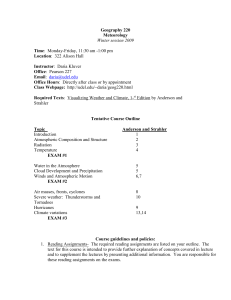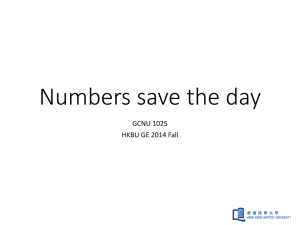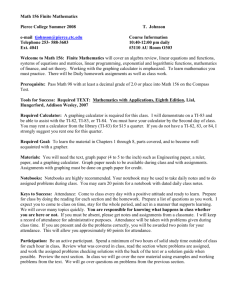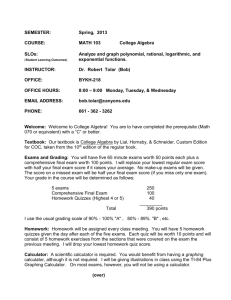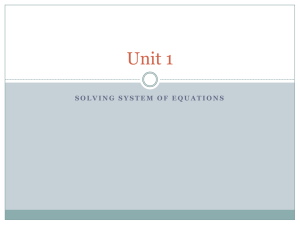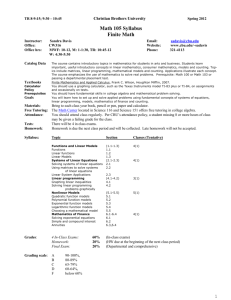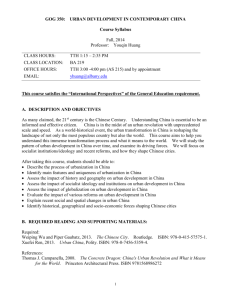GRCC Finite Mathematics - Green River Community College
advertisement
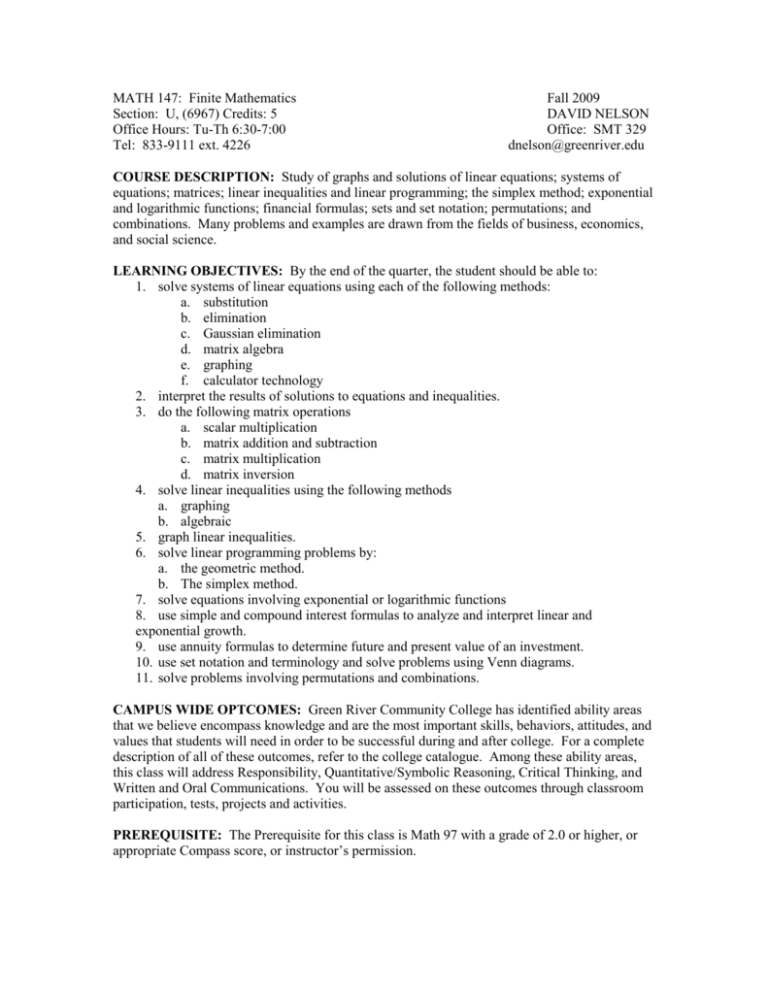
MATH 147: Finite Mathematics Section: U, (6967) Credits: 5 Office Hours: Tu-Th 6:30-7:00 Tel: 833-9111 ext. 4226 Fall 2009 DAVID NELSON Office: SMT 329 dnelson@greenriver.edu COURSE DESCRIPTION: Study of graphs and solutions of linear equations; systems of equations; matrices; linear inequalities and linear programming; the simplex method; exponential and logarithmic functions; financial formulas; sets and set notation; permutations; and combinations. Many problems and examples are drawn from the fields of business, economics, and social science. LEARNING OBJECTIVES: By the end of the quarter, the student should be able to: 1. solve systems of linear equations using each of the following methods: a. substitution b. elimination c. Gaussian elimination d. matrix algebra e. graphing f. calculator technology 2. interpret the results of solutions to equations and inequalities. 3. do the following matrix operations a. scalar multiplication b. matrix addition and subtraction c. matrix multiplication d. matrix inversion 4. solve linear inequalities using the following methods a. graphing b. algebraic 5. graph linear inequalities. 6. solve linear programming problems by: a. the geometric method. b. The simplex method. 7. solve equations involving exponential or logarithmic functions 8. use simple and compound interest formulas to analyze and interpret linear and exponential growth. 9. use annuity formulas to determine future and present value of an investment. 10. use set notation and terminology and solve problems using Venn diagrams. 11. solve problems involving permutations and combinations. CAMPUS WIDE OPTCOMES: Green River Community College has identified ability areas that we believe encompass knowledge and are the most important skills, behaviors, attitudes, and values that students will need in order to be successful during and after college. For a complete description of all of these outcomes, refer to the college catalogue. Among these ability areas, this class will address Responsibility, Quantitative/Symbolic Reasoning, Critical Thinking, and Written and Oral Communications. You will be assessed on these outcomes through classroom participation, tests, projects and activities. PREREQUISITE: The Prerequisite for this class is Math 97 with a grade of 2.0 or higher, or appropriate Compass score, or instructor’s permission. REQUIRED COURSE MATERIALS: TEXT: Frank C. Wilson, Finite Mathematics and Applied Calculus. CALCULATOR: A graphing calculator is required. Although any brand of graphing calculator will work, I will be using a TI-83 in class and it is recommended that you use either the TI-83 or the TI-84. GRADING: Your grade will be based on four components: Homework & In-Class Activities, Projects, a Midterm Exam, and a Final Exam. The weight of these components is summarized in the table below Homework & In-Class 30% Projects 20% Exams 30% Final Exam 20% Grades will be assigned according to your overall percentage, with a 95% earning a 4.0, a 94% equates to a 3.9, a 93% equates to a 3.8, and so on. You need to earn a grade of 2.0 (75%) to meet the prerequisite for the following math classes. HOMEWORK & IN-CLASS ACTIVITIES: Your homework score is based on two components: problems from the text and in-class assignments. Required problems from the text are listed later in the syllabus. On days homework is due, I will select 4 or 5 problems from the list and will ask for volunteers to come to the board and answer the questions. You will earn up to 10 points for each problem you do. Points will be awarded for volunteering and being prepared to provide an answer to the questions. I expect every student will make at least 4 trips to the board during the quarter. Homework papers will not be collected. In-class assignments: Occasionally we will have in-class assignments or group miniprojects that will count as homework as well. These in-class assignments may be turned in late, but will be subject to a 10% penalty. PROJECTS: There will be a project for almost every unit of material we cover. These will be written reports and should look similar to something you would turn into a boss. These projects will be due at the BEGINNING of class. Late projects will be subject to a 10% penalty. EXAMS: The exams and final are tentatively scheduled on the attached calendar. In the event that you must miss an exam for a valid reason, a makeup may be available. Any exam taken late will be subject to a penalty of at least 10%. STUDENTS SUBJECT TO PROVISIONS OF AMERICANS WITH DISABILITIES ACT: If you believe you qualify for course adaptations or special accommodations under the Americans With Disabilities Act, it is your responsibility to contact the Disability Support Services Coordinator, in the LSC and provide the appropriate documentation. If you have already documented a disability or other condition which would qualify you for special accommodations, or if you have emergency medical information or special needs I should know about, please notify me during the first week of class. You can reach me by phone or you can schedule an office appointment. My phone and office are listed at the top of this document. If you use an alternative medium for communicating, let me know well in advance of the meeting (at least one week) so that appropriate accommodations can be arranged. Disability Support Services is located in LSC 126 and may be contacted at: (253)833-9111 x 2631 or TDD at (253) 288-3359. ATTENDANCE: Attendance is strongly recommended. You will be responsible for all material presented in class, some of which may not be in the text. LATE WORK: You must take exams at the scheduled time, including the final. If you must miss an exam for any reason, notify me before the exam. Make-up exams may be available provided that I have been notified before the exam, and a reasonable excuse is offered. Any project, quiz or exam taken late will be subject to a penalty of at least 10%. All late assignments must be completed by December 8th. CHEATING: Students who engage in behaviors that may be interpreted as cheating will receive a zero score on the assignment in question. A second offense will result in a 0.0 course grade. Common “cheating” behaviors include talking with another person during an exam, using notes on an exam unless specifically authorized, and copying answers from someone else’s exam. WITHDRAW: If you stop attending class and fail to properly withdraw, you will receive a failing grade. The last day to withdraw is November 13th. PASS/NO CREDIT: To take the class Pass/No Credit you must notify registration by November 13th. (A grade of P does not meet the prerequisite for Math& 148 or Math 256) WHERE TO GO FOR HELP! I. Teachers' office hours Teachers are contractually obligated to have to be in their office at specific times to help students, if office hours conflict w/ your schedule, most instructors will make appointments at other times. Many teachers complain of students not using this resource. Roughly 50% of my office hours are not used by students. II. Math Learning Center SMT 355 often has times when tutors are available for drop in tutoring. Check with your instructor or the Math Learning Center for specifics. III. Attend Class every day. Although attendance doesn't directly influence your grade, there is a strong correlation between attendance and success in mathematics. IV. Do your homework. To be able to do anything well, you must practice. I have selected a list of problems that will be similar to exam questions. If you have any difficulty completing these problems, try some other problems in the same section to get more practice. You can always check your answers in the back of the book. V. Form a study group. Exchange phone numbers with some others in our class or set a time to get together and study. This is a great opportunity to make new friends and a quick source of help if you ever get stuck while working on your own. VI. Math 097 Maintenance Modules A one-credit class that helps keep your algebra skills sharp. See the Math Learning Center for more information.


